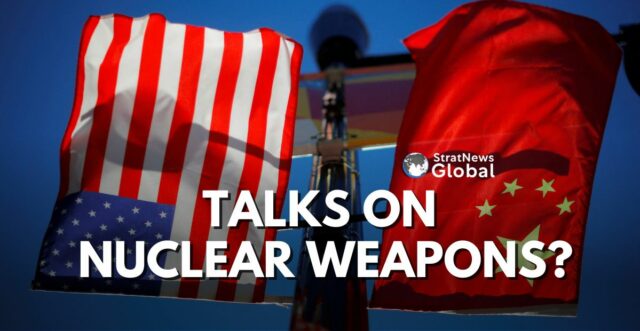The US is pushing China to break a longstanding resistance to nuclear arms talks, seeing a “limited opportunity” for early two-way conversations on the superpowers’ approach to the issue, a senior Biden administration official said.
The renewed U.S. push for nuclear talks comes as U.S. National Security Adviser Jake Sullivan met top Chinese officials in Beijing to try and resolve gaping differences on a broad range of issues.
“We saw some limited opportunity to open, at least the beginnings of conversation on the subject in the last months, but it’s been fits and starts, and I think it will continue to be fits and starts,” said the official, who sought anonymity because the matter is a sensitive one.
“They’ve signalled some willingness to start nibbling around the margins of arms control, but then they’re not very forward-leaning about following through on that,” the official said.
Referring to tension over the disputed South China Sea between China and a U.S. treaty ally, the Philippines, the official said decisions on long-term missile deployments to Manila would depend in part on China’s actions.
Nuclear Strategy Remains A Sticking Point
The two countries briefly resumed official-level talks over nuclear arms in November but those negotiations have since stalled, with a top U.S. official publicly expressing frustration regarding China’s responsiveness.
Formal nuclear arms control negotiations had not been expected any time soon, despite U.S. concerns about China’s rapid nuclear weapons build-up, even though semi-official exchanges have resumed.
The U.S. defence department estimated last year that Beijing has 500 operational nuclear warheads and will probably field more than 1,000 by 2030.
That compares to 1,770 and 1,710 operational warheads deployed by the United States and Russia, respectively. The Pentagon said that by 2030, much of Beijing’s weapons would probably be held at higher levels of readiness.
Since 2020, China has also modernised its nuclear program, starting production of its next-generation ballistic missile submarine, testing hypersonic glide vehicle warheads and holding regular nuclear-armed sea patrols.
Weapons on land, in the air and at sea give China the “nuclear triad” – a hallmark of a major nuclear power.
China has not formally detailed its arsenal but officially maintains a policy of no first use and maintaining a modern nuclear deterrence that is minimal. Officials this year urged other powers to adopt the same stance.
The Biden administration updated classified nuclear guidance this year, and a White House spokesperson previously said the update was “not a response to any single entity, country, nor threat,” despite oft-expressed concern about the nuclear arsenals of China, North Korea and Russia.
“We will continue to focus our efforts on reducing nuclear risk by enhancing deterrence and our preference for resolving differences through arms control diplomacy,” said White House spokesperson Sean Savett.
The U.S. official, who declined to speak on the record, said the scope of U.S.-China talks could initially be narrow, unlike the prior arms reduction treaty talks between the United States and Russia.
The topic is just one area where Washington wants to tamp down the potential for conflict with Beijing, among those on the agenda during three days of meetings Sullivan and other U.S. officials held in China.
In the South China Sea, China’s vessels have repeatedly clashed with Philippine ships. Washington and Manila are bound by a mutual defence treaty, and the United States has pushed for freedom of navigation in areas of the disputed waters.
Asked about the possibility of long-term missile deployment in the Philippines to aid in their defence, the U.S. official said, “with the Philippines, we’ve had capabilities as part of exercises,” referring to joint military exercises.
“We don’t, I think currently, have plans to go beyond that, but I say currently, because obviously our decisions about deployments of capabilities are informed by the context and by the actions that we see from (the People’s Republic of China).”
Chinese officials strongly condemned the deployment of a U.S. intermediate range missile system in the northern Philippines during exercises in April, saying they brought “huge risks of war into the region”.
Economic security issues also ranked high on the countries’ agenda for talks. Ahead of a deadline for confirming steep new tariff increases on certain Chinese imports, the U.S. official signalled there would be no major softening of the initial plan.
The U.S. administration was expected to announce its final plans this week after President Joe Biden unveiled sharply higher tariffs in May on Chinese goods from electric vehicles to lithium-ion batteries, to shield U.S. firms from Chinese excess production.
But U.S. industry has pressured the administration to soften the initial proposals.
And ahead of the November presidential elections, the U.S. official said a clear message was being sent to the Chinese about election interference: they were “unequivocal that that would be intolerable to us.”
(With Inputs from Reuters)





